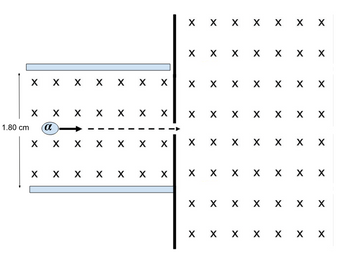An ?-particle is passing through a velocity selector and into a mass spectrometer. The parallel plates (blue) are separated by 1.80 cm and the magnetic field direction is as indicated on the diagram. The velocity of the alpha particle is 5.80 x 104 m/s. The magnitude of the magnetic field is 0.0350T. Determine the magnitude and direction of the magnetic force. Properly label or clearly indicate which plate is positive and which is negative. Determine the electric field strength Determine the potential difference across the plates. Where will the ?-particle hit the detector wall shown in black. An exact numerical value and location is required. Note: An ?-particle consists of 2 protons and 2 neutrons These values might be helpful: Mass of a proton: 1.6710-27 kg Charge of a proton: 1.610-19 C Mass of a neutron: 1.6710-27 kg Charge of a neutron: 0 C
An ?-particle is passing through a velocity selector and into a mass spectrometer.
The parallel plates (blue) are separated by 1.80 cm and the magnetic field
direction is as indicated on the diagram. The velocity of the alpha particle is
5.80 x 104 m/s. The magnitude of the magnetic field is 0.0350T.
- Determine the magnitude and direction of the magnetic force.
- Properly label or clearly indicate which plate is positive and which is negative.
- Determine the electric field strength
- Determine the potential difference across the plates.
- Where will the ?-particle hit the detector wall shown in black.
An exact numerical value and location is required.
Note: An ?-particle consists of 2 protons and 2 neutrons
These values might be helpful:
Mass of a proton: 1.6710-27 kg Charge of a proton: 1.610-19 C
Mass of a neutron: 1.6710-27 kg Charge of a neutron: 0 C

Step by step
Solved in 4 steps

An ?-particle is passing through a velocity selector and into a mass spectrometer.
The parallel plates (blue) are separated by 1.80 cm and the magnetic field
direction is as indicated on the diagram. The velocity of the alpha particle is
5.80 x 104 m/s. The magnitude of the magnetic field is 0.0350T.
a.Determine the magnitude and direction of the magnetic force.
b.Properly label or clearly indicate which plate is positive and which is negative.
c.Determine the electric field strength
d.Determine the potential difference across the plates.
e.Where will the ?-particle hit the detector wall shown in black.
An exact numerical value and location is required.
Note: An ?-particle consists of 2 protons and 2 neutrons
These values might be helpful:
Mass of a proton: 1.6710-27 kg Charge of a proton: 1.610-19 C
Mass of a neutron: 1.6710-27 kg Charge of a neutron: 0 C
